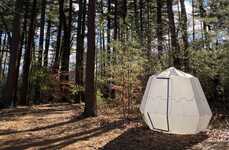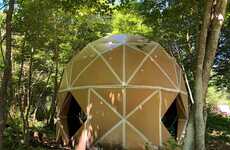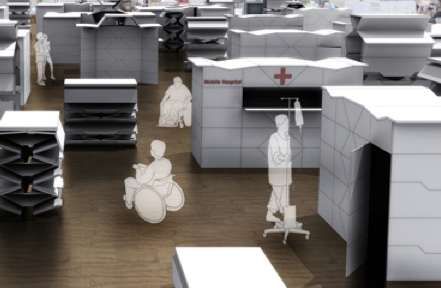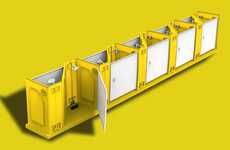
The Origami Shelter Provides Easy Emergency Protection for the Elements
Amelia Roblin — August 3, 2012 — Eco
References: yankodesign
You wouldn't want to spend weeks and weeks living in an Origami Shelter, but the concept is an exceptional one as a solution to keeping survivors a smidgeon more comfortable in the wake of a natural disaster. Perfect for bridging the resource-lacking gap as rescue and relief work get underway, the little huts can be erected out in the open or used to establish indoor communities where space is available.
Using the principles of the art of folding paper, Doowon Suh devised this system of lightweight, flatpacked dwellings that can be easily transported to earthquake, flood or hurricane-ravaged landscapes. One person alone would be capable of building an Origami Shelter in as quickly as a few minutes, ideal for becoming a temporary home, a hospital, storage or more.
Using the principles of the art of folding paper, Doowon Suh devised this system of lightweight, flatpacked dwellings that can be easily transported to earthquake, flood or hurricane-ravaged landscapes. One person alone would be capable of building an Origami Shelter in as quickly as a few minutes, ideal for becoming a temporary home, a hospital, storage or more.
Trend Themes
1. Origami Shelters - The trend of using origami-inspired designs to create lightweight and portable shelters presents disruptive innovation opportunities for emergency response organizations.
2. Quick Assembly Structures - The trend of developing quick and easy to assemble structures provides disruptive innovation opportunities for industries involved in disaster relief and temporary housing.
3. Flatpack Dwellings - The trend of using flatpacked dwellings that can be easily transported and assembled offers disruptive innovation opportunities for companies specializing in modular construction and portable housing solutions.
Industry Implications
1. Emergency Response - The emergency response industry can capitalize on origami-inspired shelters to quickly provide temporary housing and facilities in disaster-stricken areas.
2. Disaster Relief - The disaster relief industry can explore the use of quick assembly structures to efficiently establish temporary shelters and medical facilities for affected communities.
3. Modular Construction - The modular construction industry can tap into the demand for flatpack dwellings to offer easily transportable and customizable housing solutions for various purposes.
2.8
Score
Popularity
Activity
Freshness























